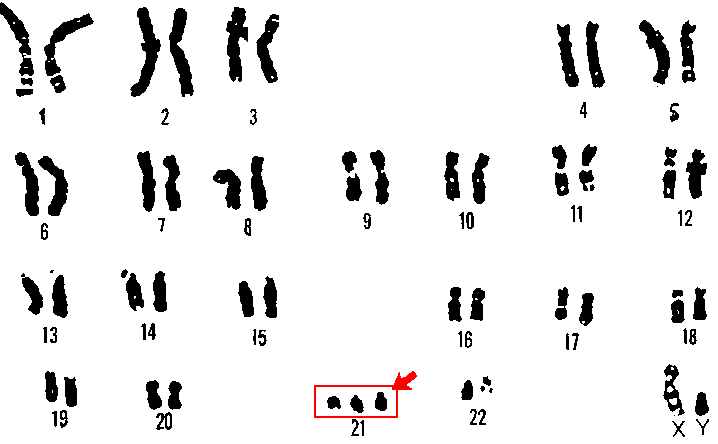Trisomie 21
What is Down Syndrome?
Medical explications
Trisomy 21 is the most common genetic abnormality, affecting about 1 in every 600 to 1,000 births. It exists throughout the world and affects all races and ethnic groups, all strata of the population, regardless of social level.
The cells of people with Down’s Syndrome or Trisomy 21 contain an extra copy of chromosome 21. Typically, each of our cells contains 23 pairs of identical chromosomes in pairs, so 46 chromosomes in all. When the sex cells, sperm or eggs are formed, the two members of each pair separate, each of these cells contains only one copy of each chromosome. Sometimes, however, this separation does not occur and the two chromosomes of the same pair remain together. This defective "meiosis" can affect several types of chromosomes, with chromosome 21 at the top of the list. If such a cell now fuses during fertilization with another cell having the normal set of 23 different chromosomes, the future child will have 3 copies of this chromosome 21, hence the term trisomy 21.
Possible morphological characteristics
In addition to the distinctive morphological characteristics of people with Down’s Syndrome, such as the shape of the eyelids, a size often smaller than average, or an enlarged neck, health problems such as congenital heart malformations, a more delicate respiratory tract, and hearing and/or visual problems are frequently added to the distinctive morphological characteristics of people with Down’s Syndrome.

Possible consequences
A flattened development curve compared to the average; they take longer to learn and reach a more modest final intellectual level. Language acquisition is particularly challenging for these children. However, from one child to another, appearance as well as health problems, intellectual development as well as character can show a very wide variability, so that "the" Down syndrome as such does not exist.
Autonomy
Medical progress, educational efforts and a very slow change in mentality have made it possible that, on the one hand, the lifespan of people with Down's syndrome has increased dramatically and, on the other hand, many of them have reached a degree of independence previously unthinkable.